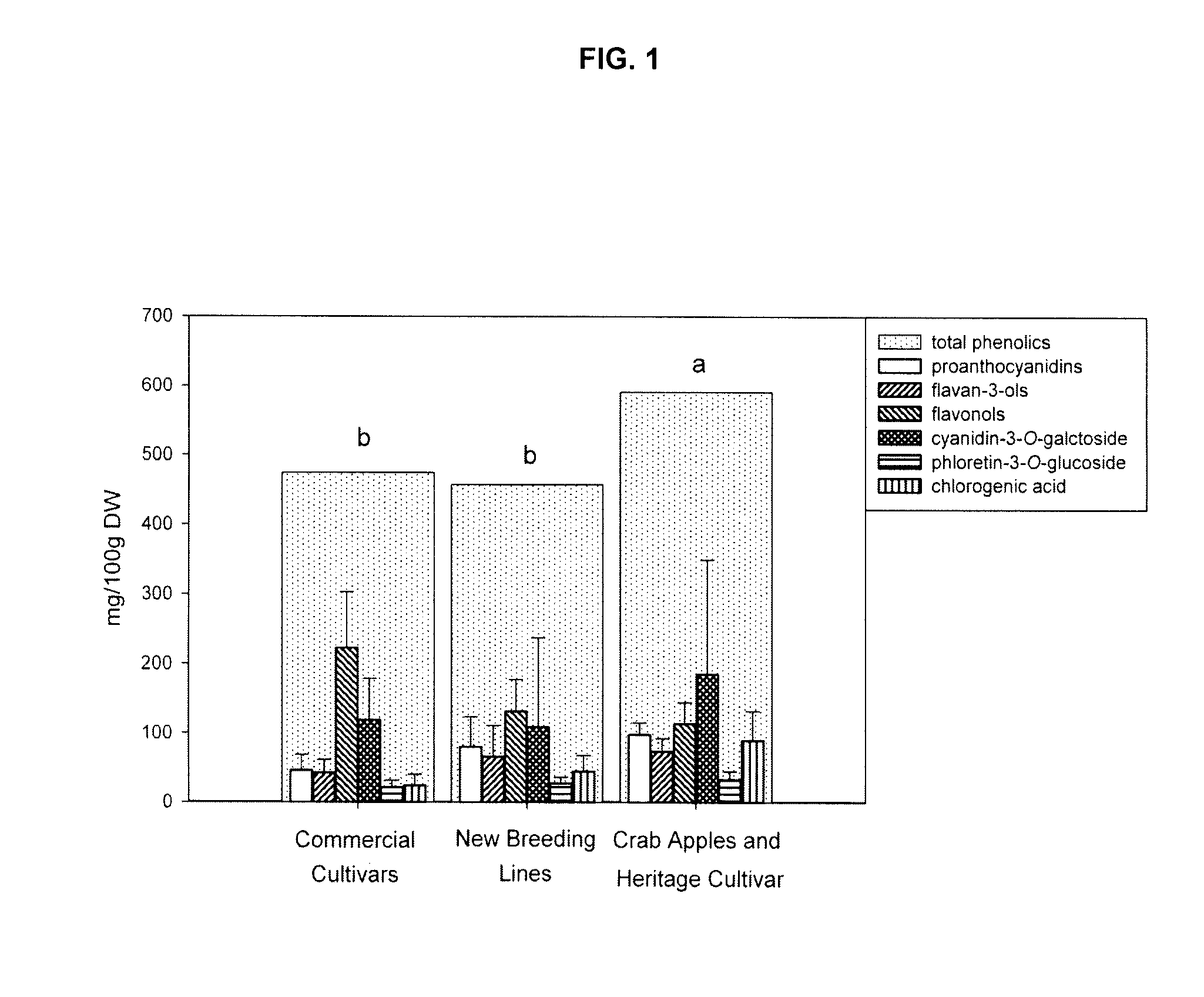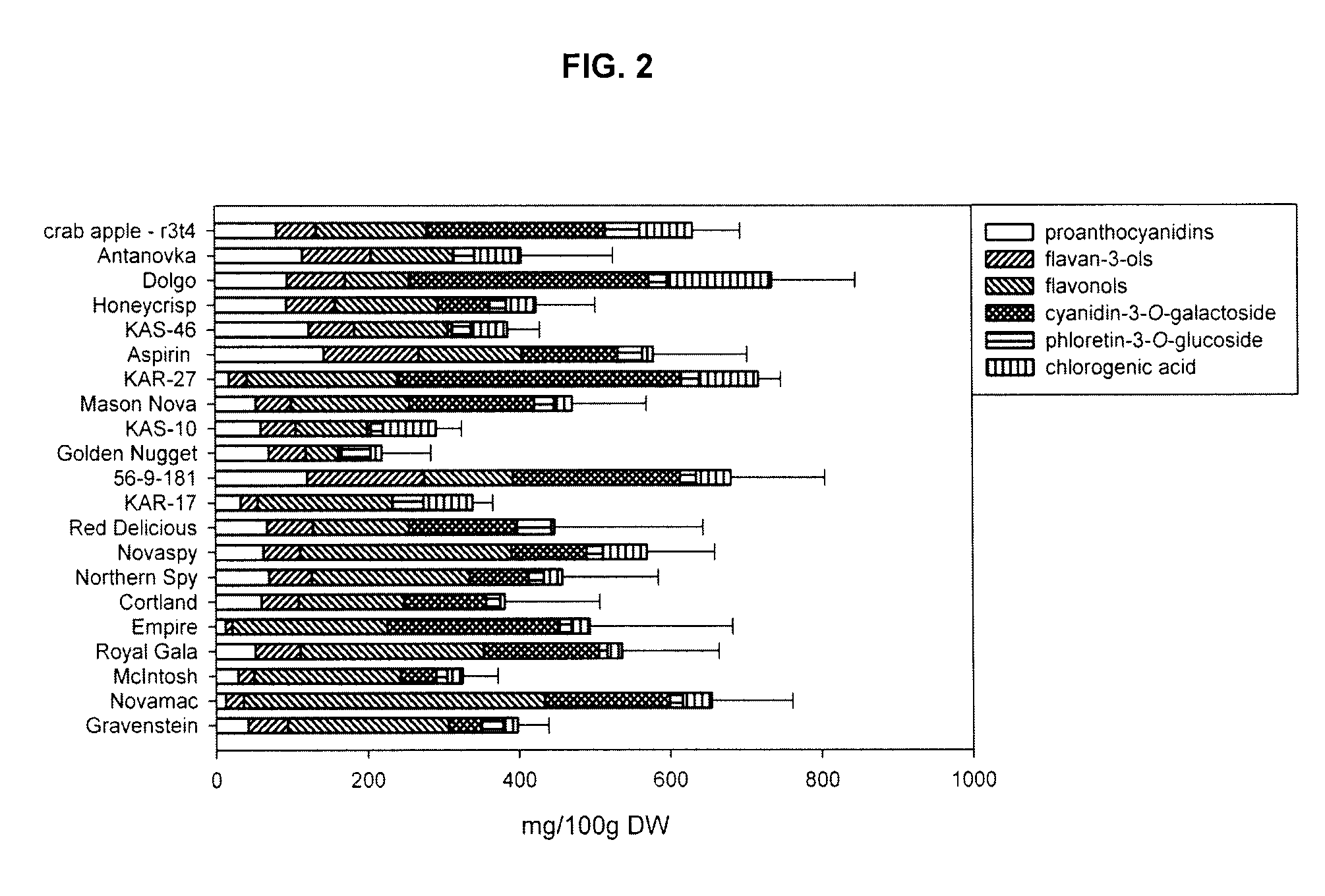Antioxidant extract from fruit skins
a technology of antioxidant extract and fruit skin, which is applied in the direction of biocide, cardiovascular disorder, drug composition, etc., can solve the problems of malonaldehyde products, adverse health effects on consumers, and inability to meet the needs of consumers, and achieve the effect of inhibiting the oxidation of methyl linolinate (ml)
- Summary
- Abstract
- Description
- Claims
- Application Information
AI Technical Summary
Benefits of technology
Problems solved by technology
Method used
Image
Examples
example 1
Phenolic Profiles and Antioxidant Properties of Apple Skin Extracts
Materials and Chemicals
[0052]Apples were harvested at commercial maturity for commercial cultivars and at physiological maturity for new breeds and crab apples / heritage cultivar during the production years of 2005 and 2006 from the Atlantic Food and Horticultural Research Center of Agriculture and Agri-Food Canada (AFHRC-AAFC), Kentville, Nova Scotia, Canada. In the first sampling year, three different trees of each genotype were selected for the collection of the commercial cultivars. Where possible, apples were collected from three different trees for each of the new breeds and crab apple genotypes. In situations where only one tree of a particular breeding line or crab apple genotypes was available, three replicates were prepared by randomly grouping apples from the same tree. In the second sampling year three replicates were randomly collected from a pool of available apples including the situations where only th...
example 2
Apple Skin Extracts to Reduce Lipid Oxidation
Materials and Methods
Chemicals
[0073]Omega-3 fatty acids ML, EPA and DHA were obtained from Nu-Chek Prep, Inc. (Elysian, Minn., USA) and the fish oil [03 / 55 TG fish oil, CFIA reg. 3529; 61% EPA, 4.3% DHA, 17.6 monounsaturated, 77.6 polyunsaturated fatty acid by weight of total fatty acids] was a generous gift from Ocean Nutrition Canada, Dartmouth, NS, Canada. Butylated hydroxyl toluene (BHT), tert-butyl hydroquinone (TBHQ), -tocopherol, 2,2-azobis(2-amidinopropane), 1,1,3,3-tetraethoxypropane (TEP), ferrous sulfate (FeSO4), ammoniumthiocyanate (NH4SCN), isooctane and trichloroacetic acid (TCA) were obtained from Sigma-Aldrich Canada. Lipid hydroperoxide standard, 13-hydroperoxyoctadecanoic acid (13-HpODE) was obtained from MP Biomedicals, Canada. The 96-well microplates were purchased from Fisher Scientific (Ottawa, ON, Canada). All other chemicals and reagent were purchased from Fisher Scientific, Canada with the highest grade in their p...
PUM
| Property | Measurement | Unit |
|---|---|---|
| of time | aaaaa | aaaaa |
| temperature | aaaaa | aaaaa |
| temperature | aaaaa | aaaaa |
Abstract
Description
Claims
Application Information
 Login to View More
Login to View More - R&D
- Intellectual Property
- Life Sciences
- Materials
- Tech Scout
- Unparalleled Data Quality
- Higher Quality Content
- 60% Fewer Hallucinations
Browse by: Latest US Patents, China's latest patents, Technical Efficacy Thesaurus, Application Domain, Technology Topic, Popular Technical Reports.
© 2025 PatSnap. All rights reserved.Legal|Privacy policy|Modern Slavery Act Transparency Statement|Sitemap|About US| Contact US: help@patsnap.com


